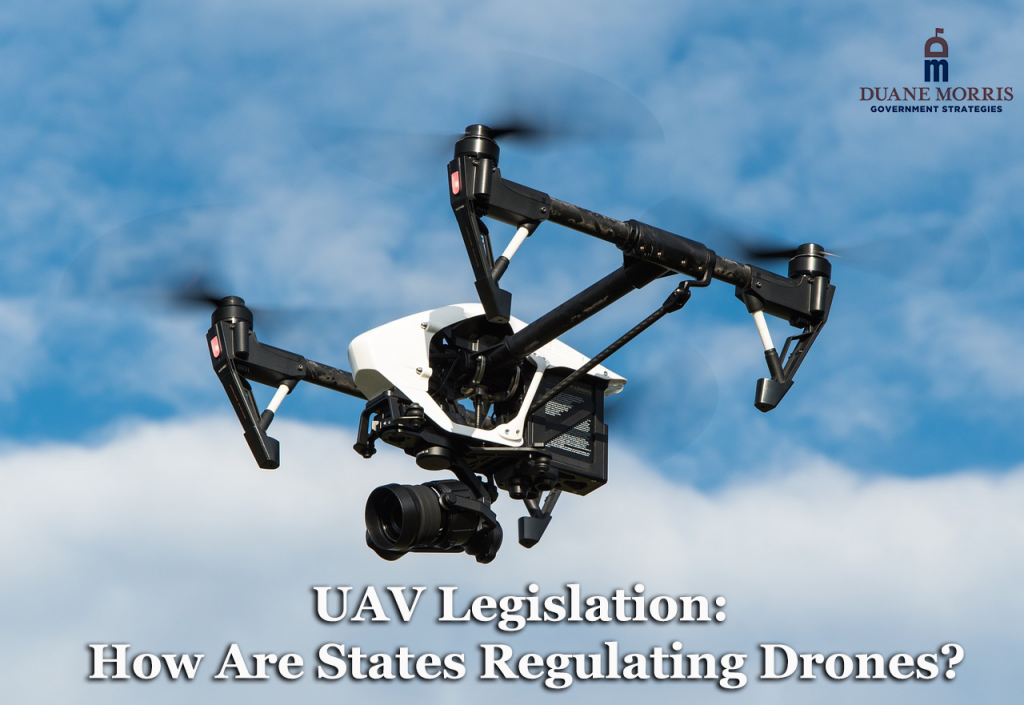
Unmanned aerial vehicles (UAVs)—more commonly known as drones—are precisely what their name suggests—crewless aerial vehicles that do not carry a human operator and instead are remotely piloted or fly autonomously. UAVs are the main components of unmanned aircraft systems (UASs), including a UAV, a ground-based controller, and a communication system between the two. When such technology became available, lawmakers across the country began regulating drones via UAV legislation.
In 2020, at least eight states (Florida, Idaho, Massachusetts, Minnesota, Missouri, South Dakota, Vermont, and Virginia) enacted 11 pieces of legislation to address UAV use and regulating drones. What did those pieces of UAV legislation accomplish? Are other states looking to pass similar legislation this session?
Alabama: 2021 UAV Legislation
This month, an Alabama lawmaker introduced HB 516, related to drones and unauthorized entry of critical infrastructure. Under current law, the unauthorized entry of critical infrastructure is a crime. This bill provides enhanced criminal penalties for damaging critical infrastructure while committing the unauthorized entry of critical infrastructure while operating certain UASs.
The bill specifically states that if someone injures, removes, destroys, or breaks critical infrastructure property or otherwise interrupts or interferes with a critical infrastructure asset’s operations while committing the crime of unauthorized entry of critical infrastructure, they are guilty of a Class C felony. The legislation further states that a person who commits the crime of unauthorized entry of critical infrastructure while possessing or operating a UAS with an attached weapon, firearm, explosive, destructive device, or ammunition is also guilty of a Class C felony.
HB 516 defines critical infrastructure to include, but not limited to, the following terms:
- A chemical manufacturing facility,
- A pipeline, a refinery,
- An electrical power generating facility and the area surrounding the facility,
- An electrical transmission tower, and substation and distribution substation,
- An electric utility control center, communication equipment, a switching station, a water intake structure and water treatment facility,
- A natural gas transmission compressor station,
- A liquefied natural gas terminal, and storage facility,
- A natural gas and hydrocarbon storage or production facility,
- Mining operations, beneficiation infrastructure, and mining infrastructure, and
- A transportation facility, such as a port, railroad operating facility, or trucking terminal.
The legislation further defines a UAS as a powered, aerial vehicle that does not carry a human operator, uses aerodynamic forces to provide vehicle lift, may fly autonomously through an onboard computer or be piloted remotely, and may be expendable or recoverable.
Florida: 2021 and 2020 UAV Legislation Regulating Drones by Law Enforcement
One bill in Florida’s current legislative session would address the use of drones by law enforcement. Senate Bill 44 would expand drones’ use by law enforcement agencies, fire departments, state agencies, and political subdivisions. Specifically, the bill would allow law enforcement agencies to use drones to gain an aerial perspective of a crowd of 50 or more people, assist with traffic management (but not issue traffic infractions based on images or video captured by drone use), and facilitate evidence collection at a crime scene or traffic crash scene.
The bill would also allow state agencies and political subdivisions to use drones for damage assessment caused by a flood, wildfire, natural disaster, vegetation, and wildlife management purposes on publicly owned land or water. Lastly, the bill would also allow certified fire department personnel to use drones to perform tasks within the scope and practice under their certification.
Last year, lawmakers in Florida passed two pieces of UAV legislation. Governor Ron DeSantis signed House Bill 659 into law in June 2020. Before the law passed, Florida restricted drones’ use by individuals and government entities to conduct surveillance. Florida also did not allow law enforcement to use a drone to gather evidence or other information.
The UAV legislation allows the use of a drone by a non-law enforcement employee of the Fish and Wildlife Conservation Commission or the Florida Forest Service to manage and eradicate invasive exotic plants or animals on public lands and suppress and mitigate wildfire threats. The bill noted studies that have shown that drones can, efficiently and inexpensively, cover an extensive geographic range and access places humans cannot, and carry a variety of cameras and sensors to collect biological specimens and target and eliminate individual organisms through the ballistic application of herbicides.
Further, House Bill 5001, the general appropriations bill, appropriated $400,000 in nonrecurring UAVs funds to detect pythons. The bill also appropriated $14 million to colleges for students who earn industry certificates during the 2020-2021 academic year. Funding for colleges is based on students who earn industry certifications in numerous areas, including UASs.
Idaho: 2020 UAV Legislation
Lawmakers in Idaho passed House Bill 486 in March of 2020. HB 486 specifically allows for the use (by law enforcement, fire department, or other local or state government entity) of a UAS under certain circumstances, including to:
- Assist with traffic accident documentation or reconstruction;
- Help with crowd or traffic management of an event by providing an aerial perspective of the public streets and intersections leading to and from a sports or entertainment arena, fairgrounds, stadium, convention hall, special event center, amusement facility, outdoor concert venue, plaza, or special event area, as long as the law enforcement agency shall not issue traffic infraction citations based solely on images or video captured by a UAS;
- Assess damage due to a natural disaster of fire;
- Train people in operation and use of a UAS, if any images or video captured during training shall not be used as evidence in any criminal proceeding;
- Assist in search and rescue operations, crime scene investigations, or temporary law enforcement use of a UAS to respond to emergencies in which there is an imminent threat to lives or property, or to respond to an emergency affecting public safety; or
- Following the issuance of a warrant, where a warrant is required under Idaho or federal law.
Minnesota: 2020 Regulating Drones Over Prisons
SF 3258 passed the Minnesota legislature last May, addressing UAVs flying over a state prison. The bill defined a UAV as an aircraft operated without the possibility of direct human intervention from within or on the aircraft.
Specifically, the bill stipulated that a person is guilty of a misdemeanor who knowingly flies a UAV in the airspace over a state correctional facility or the grounds belonging to or land controlled by the facility without the written consent of the commissioner of corrections or their designee. Further, a person who violates this is guilty of a gross misdemeanor if they use the UAV to record images, including videos of photos of the correctional facility or its grounds, or introduce or attempt to introduce any items that are not contraband.
Missouri: 2020 UAV Legislation Regulating Drones
Like Minnesota’s legislation, Missouri’s House Bill 1963 prohibited using a UAV within 400 feet of a correctional center. Unlike the Minnesota bill, House Bill 1963 extended the prohibition to within 400 feet of a mental health hospital or certain open-air facilities, including sports stadiums holding more than 5,000 people.
Suppose someone uses a UAV to deliver a weapon or other article that may be used to endanger the life of an offender or correctional center or mental health hospital employee or employee or guest of the open-air facility. In that case, they are guilty of a class B felony. If someone uses a UAV to facilitate the escape from confinement, it is a class C felony. The delivery of a controlled substance using a UAV is a class D felony.
Further, each of the facilities mentioned above subject to the bill must post a sign of the offense’s provisions. The sign is required to be at least 11” by 14” and be posted in a conspicuous location.
Federal Aviation Administration New Guidelines
The Federal Aviation Administration (FAA) announced in late December new rules for UASs or drones requiring Remote Identification. The new rules also allow operators of small drones to fly over people and at night under certain conditions.
The final rule on Remote ID will require most drones operating in United States airspace to have remote ID capability. This requirement will provide information including the identity, location, and altitude of drones and its control station or take-off location. Further, authorized individuals from public safety organizations may request the identity of a drone’s owner from the FAA. This new rule goes into effect in April of 2021.
The final rule on operating UASs over people will also go into effect in April of 2021. This rule permits small UAVs’ routine operations over people, moving vehicles, and at night under certain conditions. The rule allows routine operations of small UAS at night under two conditions:
- The remote pilot in command of the device must complete an updated initial knowledge test or recurrent online training, and
- The small crewless aircraft must have lighted anti-collision lighting visible for at least three statute miles that has a flash rate sufficient to avoid a collision.
The rule also permits operations over moving vehicles, providing the UAS meets the requirements of certain categories and either:
- The small UAVs must remain within or over a closed or restricted access site and all people inside a moving vehicle within the closed or restricted access site must be on notice that a small UAV may fly over them, or
- The small UAV does not maintain sustained flight over moving vehicles.
Related DMGS Articles:
Latest News
Photo credit: iStock.com/yacobchuk The use of cell phones by students in classrooms is on the rise, despite 77% of schools prohibiting cell phones at school for non-academic use. With students often disregarding these rules or [...]
In the latest episode of the "Back in Session" podcast, hosts Ryan Stevens and Ryan DeMara delve into the innovative world of AI technology applied in gun detection with Burgess Nichols from ZeroEyes. Starting with [...]
tiktok bill As many states around the country have taken action on various TikTok bills, the United States House of Representatives is considering whether to pass legislation requiring TikTok’s Chinese parent company to sell the [...]
Photo credit: iStock.com/lakshmiprasad S In 2023, DMGS covered states taking mostly executive action to ban or regulate TikTok in some capacity. Entering 2024 legislative sessions, lawmakers around the country have introduced similar legislation. Indiana: Bill [...]






Stay In Touch